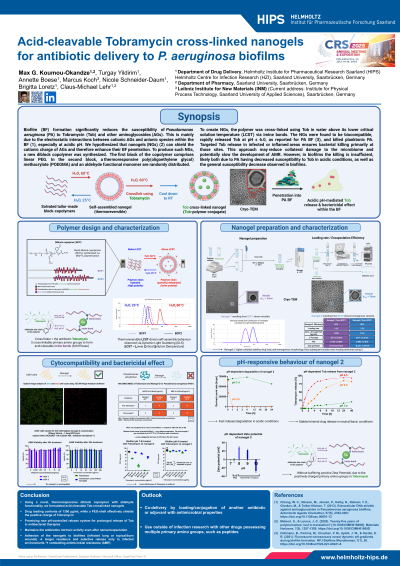Global Health, Special Population, and Women’s Health
(215) Acid-cleavable Tobramycin cross-linked nanogels for antibiotic delivery to P. aeruginosa biofilms

Introduction: Biofilm (BF) formation significantly reduces the susceptibility of Pseudomonas aeruginosa (PA) to Tobramycin (Tob) and other aminoglycosides (AGs). This is a critical concern in Antimicrobial Resistance (AMR), especially for cystic fibrosis or immunodeficient patients. The primary reason lies in the electrostatic interactions between cationic AGs and anionic moieties within the BF matrix [1], particularly under acidic conditions. We hypothesized that nanogels (NGs) [2] can shield the cationic charge of AGs and therefore enhance their BF penetration and bactericidal effect inside the PA BF.
Learning Objectives:
- Understand the morphology and properties of the Tob cross-linked nanogels as a drug delivery system
- Understand the drug loading capacity and acidic pH-mediated release possibilities of the nanogels
- Evaluate the effectiveness Tob cross-linked nanogels as a drug delivery system against P. aeruginosa
Turgay Yildirim, Dr. – Postdoctoral Researcher, Drug Delivery, Helmholtz Institute for Pharmaceutical Research Saarland; Annette Boese, Dr. – Postdoctoral Researcher, Drug Delivery, Helmholtz Institute for Pharmaceutical Research Saarland; Marcus Koch, Dr. – Head of the Core Facility for Physical Analytics, INM – Leibniz-Institute for New Materials gGmbH; Nicole Schneider-Daum, Dr. – Senior Scientist, Drug Delivery, HIPS - Helmholtz Institute for Pharmaceutical Research Saarland; Brigitta Loretz, Dr. – Senior Scientist, Drug Delivery, HIPS - Helmholtz Institute for Pharmaceutical Research Saarland; Claus-Michael Lehr, Prof. Dr. – Head of the Department of Drug Delivery, Drug Delivery, HIPS - Helmholtz Institute for Pharmaceutical Research Saarland and Saarland University

Max G. Koumou-Okandze
PhD Student
Helmholtz Institute for Pharmaceutical Research Saarland and Saarland University
Saarbrücken, Saarland, Germany

